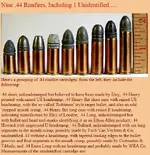DIGITMAN
Jr. Member
- Joined
- Jul 1, 2013
- Messages
- 68
- Reaction score
- 36
- Golden Thread
- 0
- Location
- california
- Detector(s) used
- Minelab SE Pro / GoldBug 2
- Primary Interest:
- All Treasure Hunting

The .44 Henry casing had a rim diameter of .518 of an inch and the casing appears to be close to that! Also, as far as I know, Henry never made anything in rimfire bigger than a .44 Rimfire but I could be wrong!
Frank
The empty brass rim-fire cartridge casing shown here, is definitely NOT a .44 caliber for a Henry rifle. The Henry rifle employed a small flat slot shaped set of double firing pins, rather than a single round pin as seen above. Also, the configuration of the cartridge firing chamber on Henry rifles, produces a unique raised bulge on the head of all fired casings. Winchester used the "H" headstamp on a vast number cartridges for many years, ranging from little .22 caliber rounds, on up through the huge .58 caliber and more.
CC Hunter
Hello Everybody...OK on the casing it measured...1 and 1/32nd of an inch OR 26mm. the Top across at 13mm. and bottom Rim at 16mm. THE Ball rounds both measure at 16mm..this is the most exact i can get with the ruler in the new pictures. Hope it helps.
